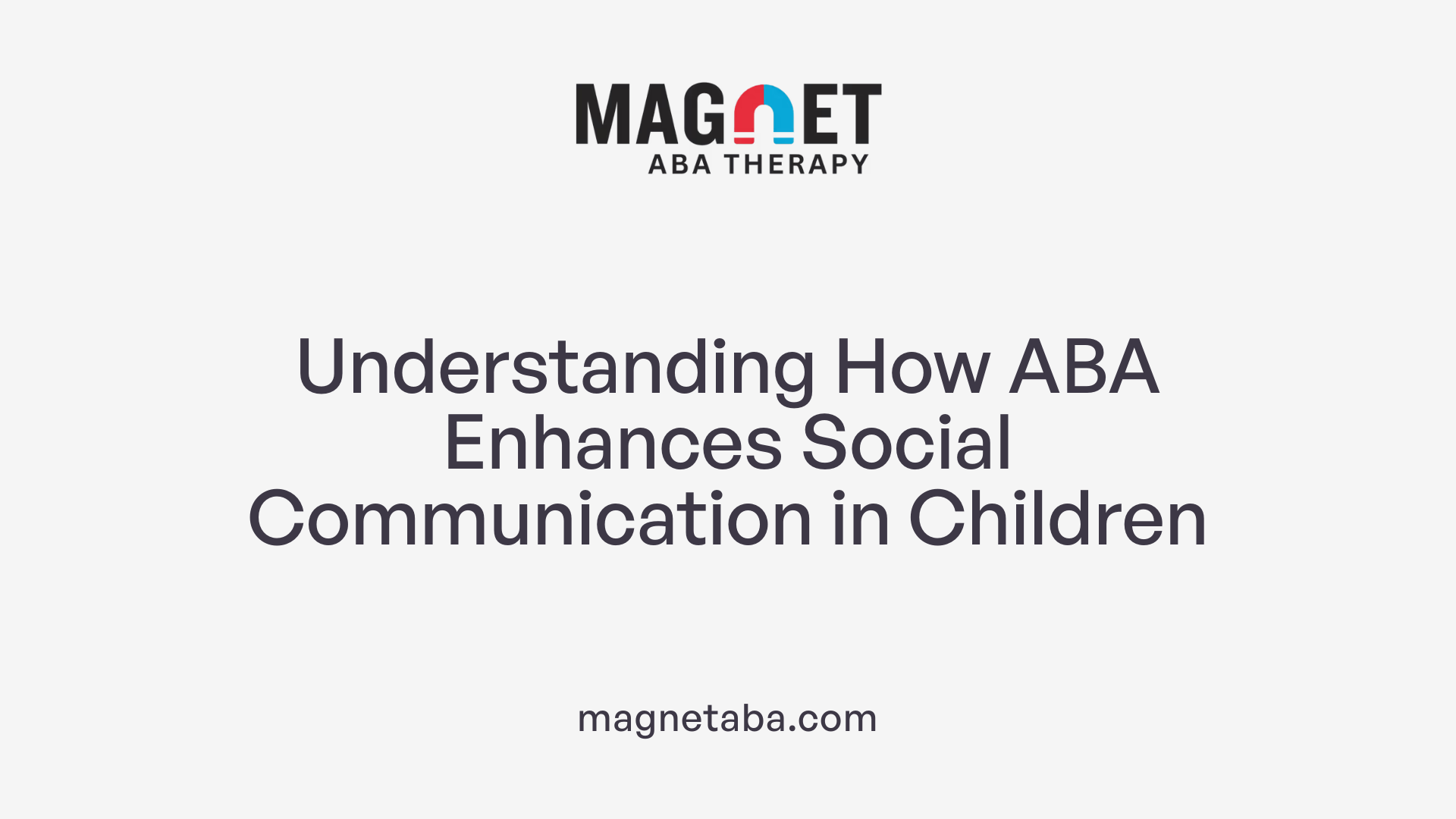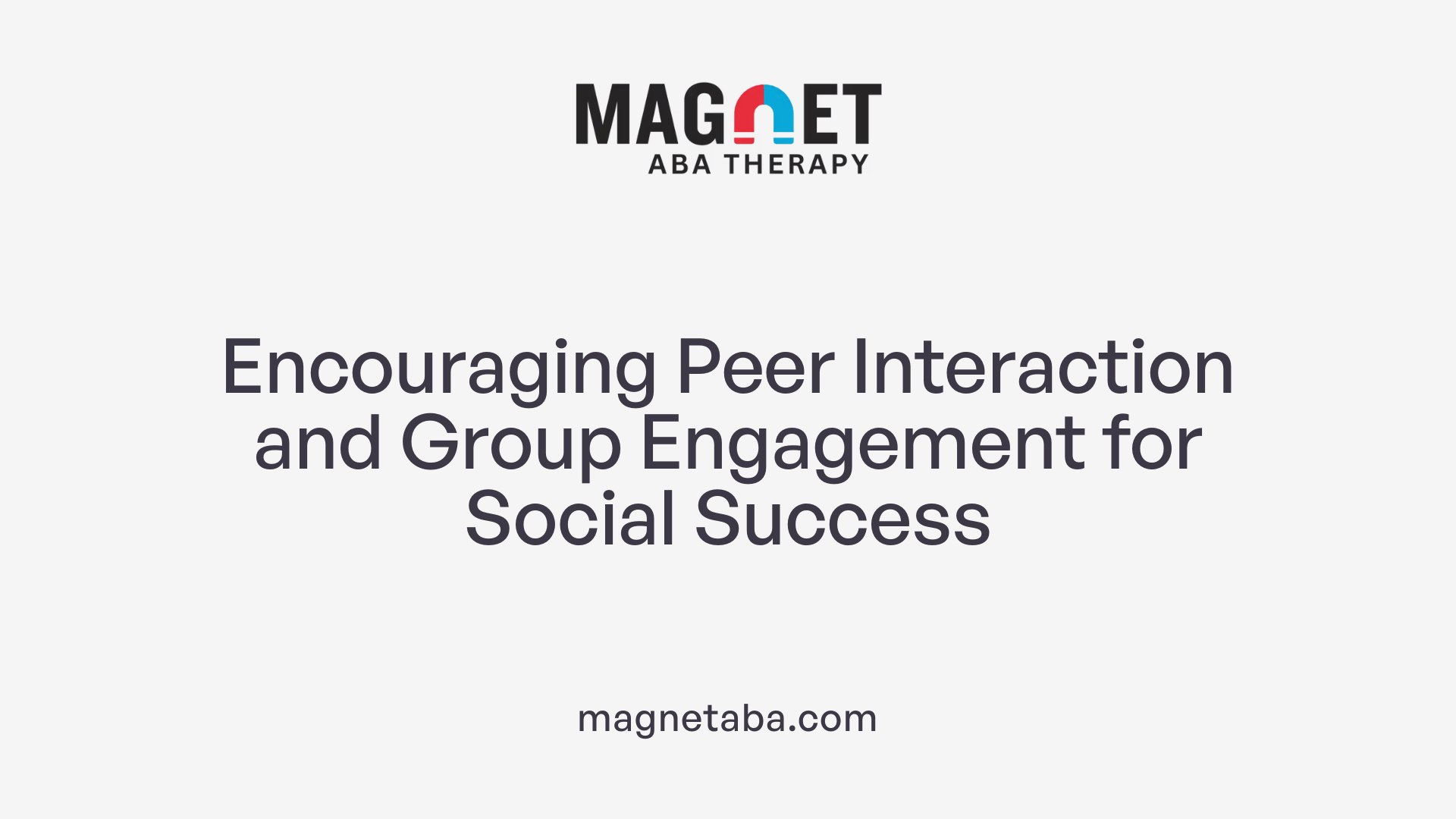Enhancing Social Communication Through Structured Interventions
Autism spectrum disorder (ASD) often presents challenges in social communication, including difficulty with turn-taking and engaging in reciprocal conversations. Applied Behavior Analysis (ABA) therapy has emerged as a leading evidence-based approach, systematically teaching children with autism to navigate social interactions more effectively. This article explores how ABA therapy enhances conversational turn-taking, the techniques employed, and the long-term benefits for social integration and independence.
Foundations of ABA Therapy for Social Skills Development

How ABA enhances social communication skills
ABA therapy plays a vital role in helping children with autism develop social communication abilities. It employs structured, evidence-based methods such as positive reinforcement, modeling, role-playing, and natural environment teaching. These techniques are designed to teach children how to communicate effectively, interpret social cues, make eye contact, initiate greetings, and understand facial expressions and body language.
Therapists design individualized plans based on each child's unique needs, developmental level, and goals. Through consistent practice within real-life interactions, children learn essential social skills in a supportive setting. For example, by using picture exchange systems or speech-generating devices for non-verbal children, ABA makes communication accessible and functional.
This approach not only improves conversational abilities but also enhances overall social engagement. Children become better at navigating social situations, which can lead to reduced frustration and increased independence, ultimately fostering meaningful relationships and social inclusion.
Techniques and Strategies in ABA for Social Skills
 ABA therapy employs a variety of methods to help children with autism develop crucial social skills such as turn-taking and reciprocal conversation. Among the primary strategies are shaping, modeling, chaining, and reinforcement. These techniques serve to break down complex social behaviors into manageable steps, teaching children to respond appropriately and build confidence over time.
ABA therapy employs a variety of methods to help children with autism develop crucial social skills such as turn-taking and reciprocal conversation. Among the primary strategies are shaping, modeling, chaining, and reinforcement. These techniques serve to break down complex social behaviors into manageable steps, teaching children to respond appropriately and build confidence over time.
Role-playing, video modeling, and storytelling are effective tools used within ABA to simulate real-life interactions in a safe, controlled environment. Role-playing allows children to practice social responses and emotional regulation, while video modeling demonstrates desirable behaviors that children can imitate. Social stories provide visual and narrative guidance, helping children understand social norms and expectations, which reduces anxiety and promotes engagement.
Visual supports are integral to reinforcing social skills in ABA sessions. Cue cards, visual schedules, and social narratives serve as prompts that assist children in understanding when and how to participate in conversations. Timers and cue cards help establish turn-taking, indicating whose turn it is to speak or listen. These visual tools make abstract social concepts more concrete, fostering independence and confidence.
To enhance turn-taking and reciprocity, ABA therapists incorporate structured activities such as games, cooperative tasks, and role-playing scenarios. For example, using talking sticks during group activities encourages children to wait for their turn to speak, fostering patience and listening skills. Rewarding successful exchanges with praise or preferred activities reinforces positive behaviors and motivates continued practice.
Gradually, therapists increase the complexity and duration of social exchanges. This step-by-step approach enables children to transfer skills from structured settings to everyday interactions. Through consistent practice and reinforcement, children learn to interpret social cues, share attention, and maintain engaging conversations—fundamental skills for building friendships and meaningful relationships.
In summary, ABA uses a combination of visual supports, modeling, role-playing, and reinforcement strategies to develop turn-taking and reciprocity. These approaches help children with autism navigate social interactions more effectively, supporting their overall social and emotional growth.
Role of Visual Supports and Natural Environment Teaching
 Visual supports such as social stories, visual schedules, and cue cards are effective tools in ABA therapy to teach and reinforce social skills. Social stories help children understand social cues, expectations, and appropriate responses in various situations, making abstract concepts more concrete. Visual schedules break down daily routines into manageable steps, reducing anxiety and providing clarity on turn-taking, sharing, and other social interactions.
Visual supports such as social stories, visual schedules, and cue cards are effective tools in ABA therapy to teach and reinforce social skills. Social stories help children understand social cues, expectations, and appropriate responses in various situations, making abstract concepts more concrete. Visual schedules break down daily routines into manageable steps, reducing anxiety and providing clarity on turn-taking, sharing, and other social interactions.
Cue cards and visual prompts serve as reminders for specific behaviors, like asking questions or making eye contact, thereby supporting children in practicing these skills consistently. These visual aids are tailored to each child's needs, promoting independence and confidence in social settings.
Embedding learning within natural activities and routines is a cornerstone of ABA. Natural Environment Teaching (NET) involves integrating skill development into everyday situations such as play, mealtime, or community outings. This approach helps children apply skills in real-life contexts, ensuring they understand how to generalize these behaviors beyond therapy sessions.
Strategies to promote the transfer of social skills across different settings include using consistent visual supports, involving peers in structured play, and creating opportunities for children to practice skills in diverse environments. For example, playing board games or participating in group activities encourages turn-taking, sharing, and collaborative play, reinforcing social behaviors learned during therapy.
By combining visual supports with naturalistic teaching methods, ABA therapy creates a supportive environment where children can develop and strengthen their social skills effectively. This synergy helps children understand social norms better, engage more confidently with others, and build meaningful relationships that last beyond structured sessions.
Implementing Turn-Taking and Reciprocal Conversation Skills

What techniques are used in ABA therapy to enhance turn-taking and reciprocity in conversations?
ABA therapy employs a variety of strategies to help children develop essential social skills like turn-taking and reciprocal conversation. One fundamental approach is modeling appropriate behaviors, where therapists demonstrate how to wait for a turn, make eye contact, and respond politely.
Visual supports also play a vital role. These include cue cards, turn-taking boards, and timers that signal when it is a child's turn to speak or listen. These visual aids help reduce uncertainty and anxiety, making social exchanges more predictable.
Structured activities such as games, sharing tasks, and role-playing scenarios are incorporated to provide practical opportunities for children to practice these skills in engaging contexts. For example, board games that require taking turns or storytelling activities that involve alternating contributions promote naturalistic learning.
Reinforcement strategies are crucial to success. Children are praised, rewarded with tokens, or given preferred activities when they wait patiently, listen actively, and respond appropriately. Such positive reinforcement encourages repeated use of social skills.
Gradually, therapists increase the complexity of these activities and extend the expected wait times. This helps children internalize the skills and transfer them across different settings and social situations.
Activities like group storytelling, using talking sticks, and collaborative play exercises are especially effective. They foster a fun and supportive environment where children can develop confidence in sharing and reciprocal engagement.
Consistent practice, patience, and positive reinforcement are essential. These methods not only teach children to take turns and share but also lay the groundwork for meaningful conversations and sustained social relationships.
By systematically applying these techniques, ABA programs help children with autism build the capacity to engage in mutually enjoyable and effective interactions, supporting their social development and integration into peer groups.
The Role of Peer Interaction and Group Settings

Encouraging peer-led activities
Incorporating peer-led activities into ABA therapy is a powerful way to boost social skills in children with autism. These activities allow children to practice social behaviors like sharing, turn-taking, and initiating conversations in real-time with their peers. Structured games, group projects, or cooperative tasks create natural opportunities for children to develop communication skills while engaging in enjoyable interactions.
Peer-led activities often foster a sense of belonging and motivation, encouraging children to try new social behaviors. By observing and participating alongside peers, children can learn social nuances such as nonverbal cues and emotional responses in a supportive environment.
Facilitating socialization and friendships
One of the core goals of ABA therapy is to help children build meaningful relationships. Facilitating socialization involves more than just practicing skills; it also depends on creating opportunities for children to connect and develop friendships.
Group settings, including peer playdates or group therapy sessions, are designed to promote these interactions. These settings provide a safe space for children to practice initiating conversations, respecting boundaries, and sharing interests. Positive reinforcement is used to encourage social behaviors, helping children experience success and increasing the likelihood of ongoing social engagement.
Using group therapy to promote generalization
Group therapy sessions are especially effective for helping children generalize social skills to everyday life. In these sessions, children encounter diverse social situations where they can apply skills learned in one-on-one ABA therapy.
During group interactions, children practice turn-taking, responding to social cues, and participating in collaborative activities. Facilitators use modeling, role-playing, and visual supports to guide children through these interactions. Repeated engagement in group settings ensures that social skills are not only learned but also maintained and used in real-world contexts.
| Strategy | Description | Benefits |
|---|---|---|
| Peer-led activities | Children participate in activities led or guided by peers | Enhances motivation, mimics real-life social interactions |
| Group therapy | Structured sessions with multiple children | Promotes generalization, social diversity |
| Reinforcement techniques | Reward of social behaviors | Encourages consistent practice and skill mastery |
As children develop their social skills through these methods, they are more likely to enjoy social inclusion, form friendships, and participate actively in community settings. These experiences contribute to their overall social and emotional well-being, supporting their journey toward greater independence and improved quality of life.
Long-Term Impact and Broader Social Benefits of ABA
How does ABA therapy impact social interaction and communication skills in children with autism?
ABA therapy is highly effective in boosting social skills and communication abilities in children with autism. By using systematic methods like modeling, role-playing, and positive reinforcement, ABA helps children learn to interpret social cues, such as body language and facial expressions. It encourages behaviors such as making eye contact, greeting others, and engaging in reciprocal conversations.
The therapy's structured approach allows skills to be broken down into manageable parts, making learning more accessible. It also provides opportunities for children to practice these skills in various environments—whether through one-on-one sessions, group activities, or natural settings—which helps them generalize what they learn.
Research and endorsements from reputable organizations support ABA as a primary intervention. It delivers measurable improvements not only in social interactions but also in overall adaptive behaviors. The flexibility of ABA, combined with its evidence base, ensures it remains one of the most recommended therapies for children with autism seeking to develop stronger social and communication skills.
Building friendships and social inclusion
As children improve their social skills through ABA, they become more capable of forming friendships and engaging with peers. Techniques like social stories, visual supports, and role-playing help children learn turn-taking, sharing, and respecting personal boundaries. These skills are critical for meaningful social participation and inclusion.
Children can become more confident in social settings, which leads to increased opportunities for community involvement and peer relationships. Structured activities such as group play, board games, and cooperative tasks foster social bonds and promote acceptance.
Improving communication and independence
ABA therapy supports the development of functional communication skills, including requesting, labeling, and conversational abilities, often with the aid of augmentative and alternative communication (AAC) devices for non-verbal children. As communication improves, children gain independence in expressing their needs and interacting with others.
This increased independence extends to academic settings and everyday life, empowering children to participate more fully in routines and activities. The ability to communicate effectively also reduces frustration and challenging behaviors, which further enhances social integration.
Enhancing self-esteem and family bonds
Success in social skill acquisition boosts children’s self-esteem, reinforcing their desire to participate and connect with others. As children experience positive interactions, their confidence grows, encouraging continued social exploration.
Moreover, ABA involves parents and caregivers in the therapy process. Training families to reinforce skills at home creates a supportive environment that fosters stronger family bonds. Watching children develop their social capacities often brings families closer, as they celebrate progress and work together toward shared goals.
| Aspect | Focus Area | Outcomes | Examples |
|---|---|---|---|
| Social Relationships | Friendships & Inclusion | Better peer interactions, social participation | Playing games, group activities |
| Communication & Independence | Verbal and non-verbal skills | Requesting, socializing, self-advocacy | Using AAC devices, engaging in conversations |
| Self-Image & Family | Self-esteem & bonding | Increased confidence, stronger family relationships | Celebrating milestones, collaborative goals |
Through these integrated benefits, ABA therapy not only enhances immediate social behaviors but also paves the way for a fulfilling, inclusive, and independent life for children with autism.
Supporting and Reinforcing Social Skills at Home and Community
How does ABA therapy support the development of conversational competence?
ABA therapy plays a vital role in helping children with autism develop strong conversational skills. It does this through a carefully structured process that teaches both expressing oneself and understanding others. By breaking social behaviors into smaller, manageable parts—such as making requests, responding to questions, maintaining eye contact, and reading social cues—ABA makes learning achievable.
Therapists use various techniques like modeling, prompting, and positive reinforcement to teach these skills. For example, they may demonstrate how to initiate a conversation or take turns during play. Role-playing activities create safe spaces for children to practice social interactions, while assessment tools help track progress and tailor interventions to individual needs.
Specialized approaches like Verbal Behavior Therapy (VBT) categorize communication into components called operants, including mands (requests), tacts (labels), echoics (imitation), and intraverbals (conversational exchanges). These techniques are complemented by natural environment teaching, where children learn in real-life settings, and augmentative communication systems like picture exchange or speech-generating devices for non-verbal children.
Overall, ABA's systematic approach ensures that children not only acquire communication skills but also generalize them across different settings. As they become more confident in their ability to converse, children can foster friendships, participate more in academic and social activities, and build greater independence.
Transforming Social Lives Through ABA
ABA therapy plays a crucial role in developing conversational turn-taking in children with autism, empowering them to become more effective communicators and social participants. Through systematic techniques like modeling, reinforcement, role-playing, and visual supports, ABA helps children learn to initiate, respond, and maintain reciprocal conversations. The approach's emphasis on individualized goals, natural environment integration, and real-world practice ensures that these skills are generalized and sustained. The long-term benefits include improved social relationships, greater social inclusion, and increased independence, ultimately transforming children’s social lives and fostering lifelong friendships and community engagement. While ABA remains one of the most researched interventions, ongoing adaptations and parental involvement continue to enhance its effectiveness, making it a vital tool in nurturing social competence and meaningful connections.
References
- How ABA Therapy Helps With Social Skills
- How ABA Therapy Can Improve Communication Skills in ...
- ABA Therapy for Social Skills Development in Autism
- Strategies for Teaching Turn-Taking in Autism
- Effectively Teaching Social Skills in ABA
- How to Teach Turn-Taking to an Autistic Child
- ABA as a Teaching Method for Autism
- ABA therapy enhances Social Skills
- Enhancing Communication Skills With ABA Therapy












